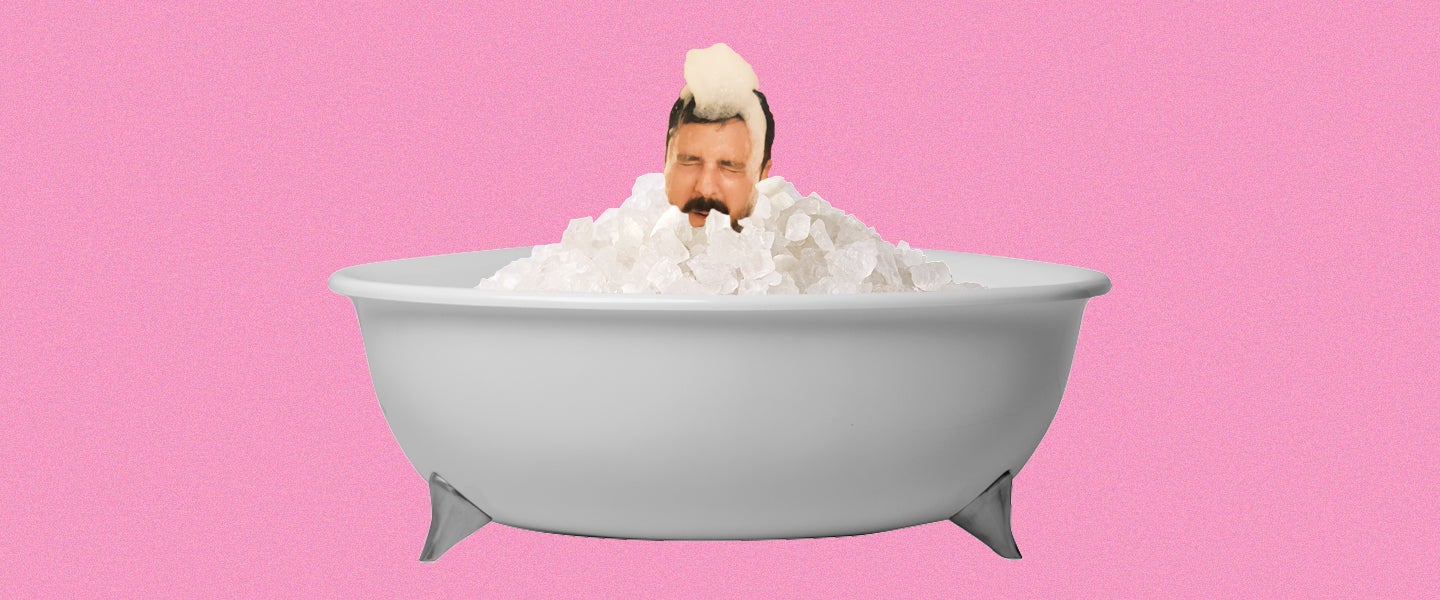I often feel like a ball of stress when I get home from the office. It’s not the work, per se, that stresses me out — I quite like what I do, and the people I work with, and while I work hard at my job, I don’t feel like the work I do runs me the way many others do.
For me, the stress is personal: Am I taking the right kind of care of myself, physically and mentally? Am I making the right decisions financially? Will I ever begin saving enough money to buy a house, raise kids, or fuck, retire? Am I giving my relationship with my girlfriend the right amount of attention? Is there any more I could be doing for my parents?
Which is to say, if someone handed me a panacea that promised to relax my body and my mind, and told me the experience of taking it was even better than its after-effects, I’d take that shit in a heartbeat.
Cue the magnesium bath, the cure for all that ails you.
I can’t remember the last time I took a bath — scratch that, it was last year, but that involved soaking in hot-ass water with onions in my armpits to cure a cold or whatever. But prior to that, I honestly can’t remember.
Historically (or at least in recent times), baths have gotten a bad rap. Which is dumb. Because baths are essentially jacuzzis in your home, admittedly minus the jets and a significant amount of space. IMHO, water + heat = pure relaxation — if, of course, you can stomach sitting in your own filth. The addition of magnesium to baths, however, has made them a popular new wellness trend as the holistic medicine crowd has become crazed with all the supposed health benefits of the Earth’s eighth most abundant element.
Either way, I was definitely sold — and more than game to add a bit of the magical magnesium to my human-soup mix to see if I could potentially melt all my troubles away.
The Problem: I’m a stress monster.
The Alleged Cure-All: Magnesium, an alkaline earth metal with the symbol Mg and the atomic number 12 on the Periodic Table, and a nutrient that our bodies require to stay healthy.
Magnesium is found in all types of food that we already eat — legumes, nuts, leafy green vegetables and dairy to name a few, according to the National Institutes of Health. You can also find magnesium in pill form to take as a daily supplement, or in many topical creams and oils, since magnesium is easily absorbed through the skin.
For my purposes, though, I’m focused on magnesium sulfate, i.e., the salt formerly known as Epsom, which homeopaths have gotten really excited about recently as a low-cost, low-lift stress reducer, pain reliever and sleep improver.
I know what you’re thinking: Epsom salts? Haven’t they been around since olden times? Why, yes, they have, but when was the last time you took an Epsom salt bath, and did you ever consider all the cool shit it was doing for you? My guess is the answer is no. People are rediscovering the efficacy of all types of formerly boring stuff — I mean, do you remember the juice craze from three years ago? That was literally fruit juice. What, just because it costs $7.99 at CVS, and not a thousand dollars, it’s less effective?
You should be thanking me for saving you the cost of seeing a therapist for your stress, or the cost of a portable sauna for the aches and pains.
How to Waterproof Your Phone for the Bath (or Shower): Place phone in one sandwich-sized Ziploc bag. Fin.
The Science: So what’s happened between the time your granddad soaked his tired hooves in Epsom salts and magnesium’s triumphant return in 2019? Well, people got hip to the fact that magnesium can do some crazy cool shit, and that we humans don’t get nearly as much of it into our systems as we once did.
Again, per the National Institutes of Health, magnesium is present in more than 600 types of enzymatic reactions in the human body, meaning it’s pretty damn important to a healthy lifestyle. Unfortunately, most Americans live with a magnesium deficiency, largely due to modern agricultural methods and the increased use of fertilizers that bind to and neutralize magnesium in the soil, and the use of magnesium-binding fluoride in our water supply.
Taking a magnesium bath then is a great way to rebalance magnesium levels by allowing the elemental magnesium to be absorbed through the skin. And that rebalancing comes with a host of benefits — e.g., increased insulin sensitivity, better nutrient absorption, softer skin, improved circulation and the aforementioned stress relief, pain relief and improved sleep.
Best Essential Oil for Your Magnesium Bath: Eucalyptus, with spearmint being a close second.
The Experience: Knowing that I had no chance to study whether my body would become more insulin sensitive, absorb nutrients better or if my circulation was improving, my goal was to see whether I felt like I was sleeping better, if I had less aches and pains after a hard workout, and obviously, if I felt less stressed.
My CVS purchase included two giant bags of Mr. Teal’s Epsom Salt Soaking Solution, one in the Relax & Relief flavor — which I would use after the gym — and the other labeled Soothe & Sleep, for chilling me out.
Each night I’d get home, run the bath, dump a few cups of the stuff in the water and begin the 30-minute process of soaking my bones. Some people prefer music — maybe some Sade — and candles; I, however, choose to watch movies with my waterproof speaker and my iPhone.
I’m not gonna lie, I started feeling better on the first night I took a magnesium bath. Now, I’m no scientist, and this was no double-blind study. And so, there are a number of variables besides the magnesium that might’ve accounted for why I felt so good when I got out of my bath: the heat, the mindlessness of it all, the placebo effect. But I don’t think it matters, because, in my mind, it felt like it was already working. I felt less stressed, and there was less shit bouncing around my head when I stepped out of that tub than when I got in.

To repeat, I’m not a scientist, but over time, it seemed as though I was sleeping better, too. Getting to bed felt easier; less restless thoughts kept me up past midnight. One night I even made my girlfriend mad because I was asleep before she was even done brushing her teeth (she likes to talk before she goes down for the count).
Even the pain-relief aspect appeared to work. After being out of the gym for a couple of weeks, I decided to go back and try to push myself to the point where it was almost certain I’d wake up with some delayed-onset soreness the next day. That night, though, I soaked with the Relax & Relief salts, and I swear, the soreness wasn’t as bad as it could’ve been.
Best Waterproof Speaker For Bathtime: The UE Boom 3.
The Takeaway: I don’t want to call this stuff magic, but in my case, I can’t help but think it really helped. Did every nagging worry go away? No, a magnesium bath won’t erase your mind (or alter your personality). But I know that, after even a 20- or 30-minute soak in the tub with this stuff, I felt way more relaxed. That my sleeping improved, too, only enhanced the experience further. Plus, there was a giant cherry on top: I might’ve found a tool to help me keep my momentum in the gym by preventing or mitigating soreness.
Come to think of it, maybe Epsom salts really are magic after all.
Besides, who cares if magnesium baths are bullshit? The fact is, your body needs magnesium anyway, and here’s a relaxing, inexpensive and less time-consuming way to get more of it into your bloodstream. Even if you don’t feel a thing related to all of magnesium’s other supposed benefits, improving your uptake of the stuff might be reason enough to give it a shot.
But hey, if it does work for you like it worked for me, shit, it’s a helluva lot cheaper than a therapist and a masseuse.
Jeff’s Rating: 9/10

